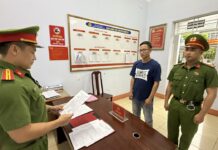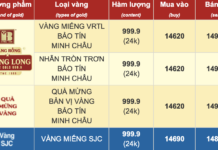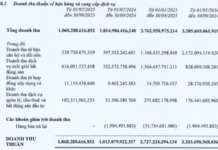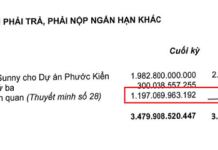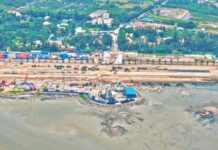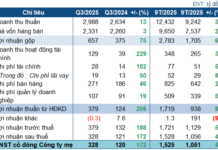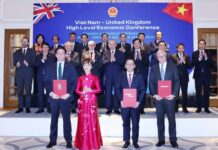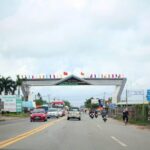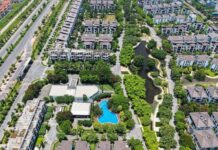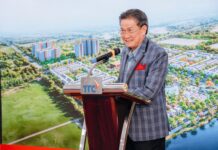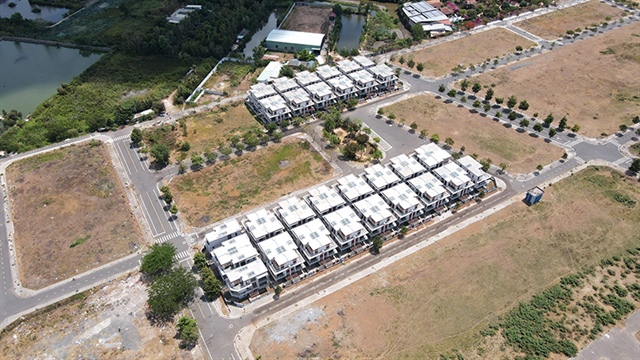
Residential land prices have surged following Ho Chi Minh City’s new land price framework. Photo: Minh Hoang |
The agricultural land segment was once highly sought-after, as prices were significantly lower than residential land. Typically, individuals would purchase these plots and apply for a conversion to residential status for construction, while enterprises or investors would subdivide and sell the plots for profit. However, with the announcement of Ho Chi Minh City’s new land pricing, this segment has come to a near standstill.
Buyers are cautious, and landowners are anxious
“I haven’t had a single transaction in the past three months,” said Hoang Duyen, a real estate broker in Hoc Mon District, Ho Chi Minh City, describing the recent stagnant state of agricultural land sales.
In reality, as observed by our team, numerous agricultural land plots in districts like Binh Chanh, Hoc Mon, and Cu Chi are being offered at significantly reduced prices compared to the past. A similar trend can be seen on real estate trading platforms, with a sudden surge in listings for agricultural land in the outlying districts and peripheral areas of the city. Many of these plots are openly advertised as being available for a “fire sale,” with prices slashed by 20-30% from their peak. However, potential buyers, whether intending to construct residences or invest, are exercising extreme caution during this period.
For instance, a 3,800-square-meter agricultural land plot on Truong Van Da Street, Binh Loi Ward, Binh Chanh District, is currently on the market for VND 12.5 billion, a reduction of VND 4 billion from its purchase price in 2021, yet it remains unsold.
“Landowners have agreed to reduce the selling price of several agricultural plots entrusted to our company by 20%. However, the anticipated costs of converting the land to residential status are expected to be significantly higher than before, making investment in agricultural land less appealing,” shared the director of a real estate brokerage firm in District 12.
Similarly, a representative of the Vietnam Association of Real Estate Brokers (VARS) indicated that they have observed a downward trend in agricultural land prices, with a decrease of approximately 10-20% due to the increased costs associated with changing the land’s purpose to residential use. Combined with the prohibition on subdividing and selling land in the outlying districts of Ho Chi Minh City, the volume of transactions in agricultural land is predicted to decline in the short term due to reduced supply and the wait-and-see approach adopted by individual investors.
In reality, the 2024 Land Law (effective from August 1, 2024) allows localities to apply the old land price framework until December 31, 2025. While other localities adhere to the old price framework, Ho Chi Minh City has announced the implementation of a new land price framework with rates significantly higher than the previous one, with increases of up to 38 times in some areas.
This change has not only left individuals and investors who trade in agricultural land “stunned and unable to react” but has also caused anxiety among households owning agricultural land who intend to convert it to residential status for construction. They now face unexpectedly high costs due to the new land price framework.
Nguyen Chi Trung, a resident of Cu Chi District, shared his experience with us. His family owns an 800-square-meter agricultural land plot in the district. After the city officially announced the new land price framework, effective from October 31, he rushed to initiate the procedure to convert the land to residential status before the new regulations took effect, hoping to benefit from the old tax rates. “I had to engage a document processing service to ensure the submission of the application before the deadline, as doing it myself would have taken too long. However, only 200 square meters of the 800-square-meter plot met the requirements for residential conversion. The rest will have to be processed later, inevitably incurring much higher taxes and fees,” said Trung.
According to Trung, the tax for converting each square meter of residential land was about VND 300,000 in the past, but it has now increased to VND 1 million. Consequently, the expected tax for converting his family’s 800-square-meter plot will be VND 800 million, a significant jump from the previous estimate of approximately VND 240 million.
However, according to VARS, land plots that have already been subdivided and have completed legal procedures will likely “experience a 10-20% price hike in the coming time.”
Agricultural land still holds potential
Despite the new land price framework making the conversion of agricultural land to residential status less appealing, this type of real estate still holds potential.
The primary reason is the rapid urbanization of Ho Chi Minh City, which is reducing the availability of land in the city center. This situation makes agricultural land, particularly real estate in the peripheral areas, attractive to both residents and investors due to its reasonable prices and convenient yet not too close proximity to the city. Additionally, these areas offer opportunities for various business models, such as ecological gardens and farm stays.
Notably, while the previous law prohibited the construction of structures on agricultural land, the 2024 Land Law, effective from August 1, now permits landowners to apply for multi-purpose land usage. This means they can use up to 50% of the land for purposes other than the primary agricultural purpose and construct easily removable structures. Furthermore, according to experts, the availability of agricultural land for such business ventures is expected to increase in the coming time.
“With the current high land prices, landowners will find it challenging to convert their land to residential status. Instead, there will be a growing focus on developing these agricultural lands for immediate use. Entrepreneurs interested in starting such ventures will have a wider choice of land for investing in infrastructure, facilities, and agricultural green spaces. Moreover, as the legal framework becomes clearer, buying, selling, and investing in agricultural land for tourism purposes will become more accessible and appealing,” said Dinh Minh Tuan, Southern Region Director of batdongsan.com.vn.
Thus, it is evident that the new legal framework has legalized and facilitated the construction and operation of businesses on agricultural land. Consequently, areas with potential for developing resorts and tourism, such as the outlying districts of Ho Chi Minh City, will particularly benefit from these new regulations.
For instance, Huynh My, the owner of Tam Nong Farm, a 1-hectare eco-tourism site in District 12, Ho Chi Minh City, shared her experience. While most households owning agricultural land in the surrounding area engage in small-scale vegetable growing and livestock farming, she has chosen to develop a tourism model to tap into the growing trend of intra-city tourism. “I’ve invested about VND 1 billion since starting this tourism venture. I’ve adopted a ‘rolling’ approach, gradually developing different areas based on customer feedback. Currently, with the implementation of the new land price framework, many investors are focusing on buying, selling, and making quick profits, but I remain committed to sustaining this business model because I believe its potential is still enormous,” said the owner of Tam Nong Farm.
According to experts, the 2024 Land Law opens up new opportunities for those operating homestays and farm stays on agricultural land, and it is expected to reinvigorate the agricultural land market in the future. A representative of VARS also noted the emergence of investors acquiring large areas of agricultural land to develop farm or combine agricultural and tourism ventures, moving away from the previous trend of subdividing agricultural land for residential development.
Similarly, Duong Dang Phuc, a real estate consulting expert, believes that real estate transactions in the peripheral areas of Ho Chi Minh City will continue to grow in popularity in the coming time. He attributes this to the influx of investors from the northern provinces seeking opportunities in the city. Mr. Phuc also mentions the impact of rising real estate prices and recent auctions in the north, as well as the progress of key infrastructure projects like the Belt Road 3 and Ben Luc – Long Thanh Expressway, which are accelerating to meet public investment capital disbursement targets. Additionally, several peripheral area infrastructure projects are nearing completion by the end of 2024 and early 2025, providing positive signals that will encourage investors to acquire more assets.
“As investors increasingly recognize the shift towards the peripheral areas due to the impact of land prices, taxes, and subdivision regulations, the demand for accumulating assets, including agricultural land, among both individuals and investors, is expected to rise,” emphasized Mr. Phuc.
Hoang An Nhu
The Great Land Use Fee Confusion: When Agencies Disagree, Citizens Pay the Price
The Institute of Resource Economics and Environment has pointed out a discrepancy between Decision 79 by the Ho Chi Minh City People’s Committee and Document 10640 issued by the Ho Chi Minh City Tax Department. The institute believes that there is a lack of alignment in interpretation, implementation, and application between the two documents, ultimately putting citizens at a disadvantage.
Why Do Businesses Still Struggle Despite 0% Long-Term Loans?
“The financial powerhouse of Ho Chi Minh City, the State Financial Investment Company, is offering an unprecedented opportunity for select priority sectors. They are committed to supporting these sectors by providing a 100% interest rate subsidy on loans for eligible projects. This bold move underscores the city’s dedication to fostering growth and development in key areas.”
The Ultimate Guide to Tay Ninh’s Inter-District Development Plan: Unveiling the Strategic Region Bordering Ho Chi Minh City
On October 31st, Mr. Nguyen Thanh Ngoc, Deputy Secretary of the Provincial Party Committee and Chairman of the People’s Committee of Tay Ninh province, along with Vice-Chairmen Nguyen Hong Thanh and Duong Van Thang, chaired the regular meeting of the Provincial People’s Committee for October. The meeting discussed several important matters.









